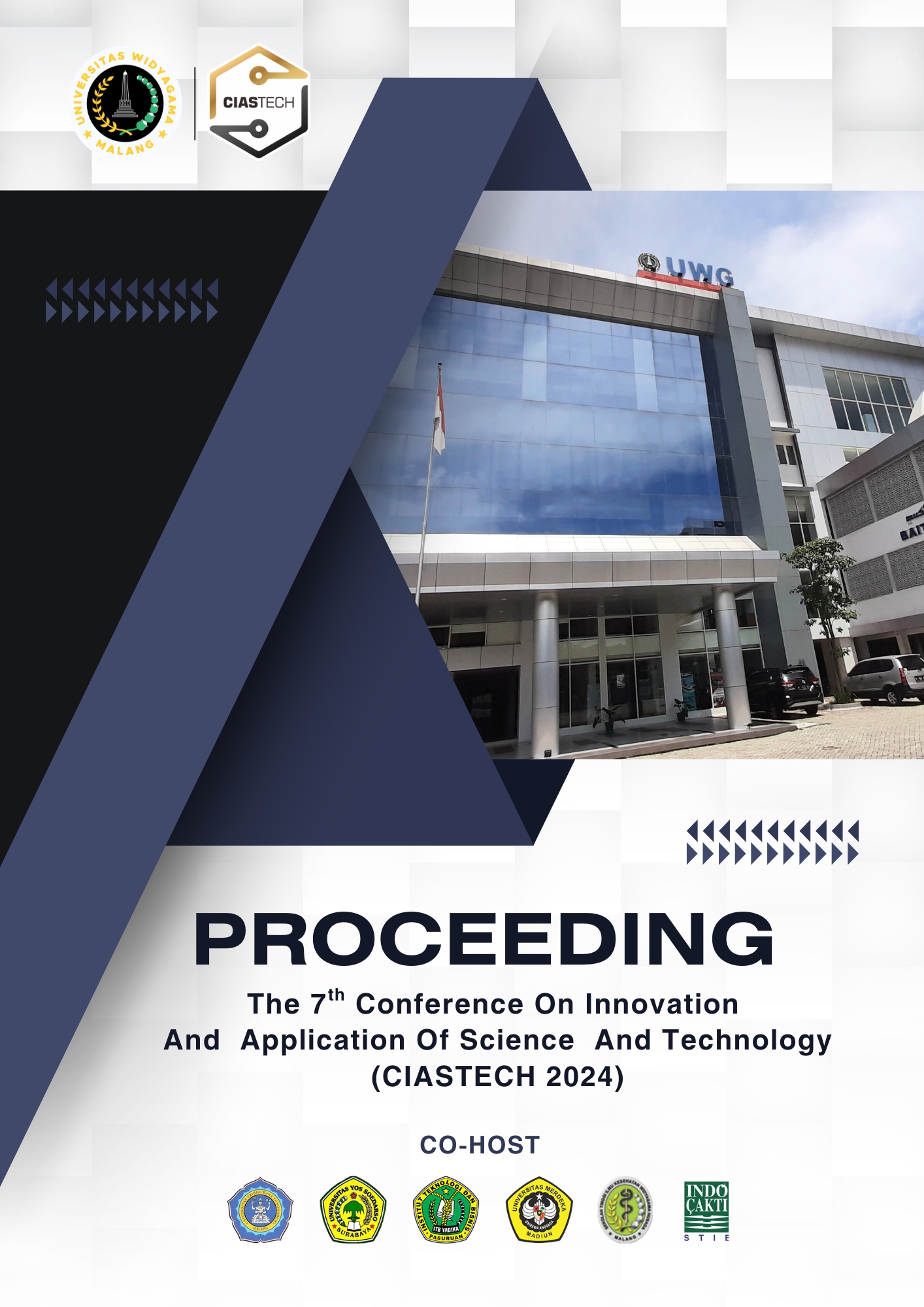PEMODELAN ROAD FEELING PADA KENDARAAN YANG MENGGUNAKAN STEER BY WIRE SYSTEM
DOI:
https://doi.org/10.31328/ciastech.v7i1.6951Keywords:
Road Feeling, Fuzzy Logic Control, MQPSO, Steer by WireAbstract
Sistem kontrol optimal untuk road feeling pada sistem SbW bertujuan untuk meningkatkan respon pengemudi dengan memberikan umpan balik torsi yang akurat. Hal ini diperlukan untuk memberikan efek rasa yang ditimbulkan oleh kondisi jalan dan memberi torsi lawan sebagai umpan balik ke tangan pengemudi tentang pergerakan kendaraan dan informasi permukaan jalan. Sistem kontrol Fuzzy Logic dibangun untuk mengendalikan sistem umpan balik road feeling pada sebuah sistem SbW. Input pada Fuzzy Logic Control terdiri dari kecepatan kendaraan, sudut kemudi, rasio kemudi, serta torsi inersia dan gesekan dalam menghasilkan torsi kemudi. Parameter FLC dioptimalkan menggunakan MQPSO untuk mencapai respon torsi road feeling yang optimal. Model Simulink dikembangkan untuk mensimulasikan sistem ini, dan hasilnya menunjukkan peningkatan kinerja FLC yang optimal dalam mengontrol umpan balik torsi motor kemudi. Paper ini berkontribusi pada bidang teknologi steer-by-wire dengan mengusulkan model kontrol torsi yang optimal, serta memberikan wawasan tentang peran FLC dan MQPSO dalam meningkatkan dinamika road feeling.References
[1] Z. Yang, G. Li, H. He, and G. Li, “Study on road feeling simulation control algorithm for four-wheel independent drive and steering electric vehicle,” in 2017 Chinese Automation Congress (CAC), Oct. 2017, pp. 4872–4875. doi: 10.1109/CAC.2017.8243641.
[2] F. Hunaini, I. Robandi, and N. Sutantra, “Optimization of automatic steering control on a vehicle with a steer-by-wire system using particle swarm optimization,” Turk. J. Electr. Eng. Comput. Sci., vol. 24; 2, pp. 541–557, Feb. 2016.
[3] D. Cheon, C. Lee, S. Oh, and K. Nam, “Description of Steering Feel in Steer-by-Wire System Using Series Elastic Actuator,” in 2019 IEEE Vehicle Power and Propulsion Conference (VPPC), Oct. 2019, pp. 1–4. doi: 10.1109/VPPC46532.2019.8952490.
[4] Liuhe, X. Zeng, and L. Shuo, “Design of road feel feedback algorithm for steer-by- Wire,” in 2020 4th CAA International Conference on Vehicular Control and Intelligence (CVCI), Dec. 2020, pp. 142–146. doi: 10.1109/CVCI51460.2020.9338568.
[5] H. Zheng, J. Zhou, and B. Li, “Design of Adjustable Road Feeling Performance for Steering-by-Wire System,” SAE Int. J. Veh. Dyn. Stab. NVH, vol. 2, no. 2, Art. no. 10-02-02–0008, Jun. 2018, doi: 10.4271/10-02-02-0008.
[6] M. S. Arslan, “A Hysteresis-Based Steering Feel Model for Steer-by-Wire Systems,” Math. Probl. Eng., vol. 2017, p. e2313529, Nov. 2017, doi: 10.1155/2017/2313529.
[7] A. Balachandran and J. C. Gerdes, “Designing Steering Feel for Steer-by-Wire Vehicles Using Objective Measures,” IEEEASME Trans. Mechatron., vol. 20, no. 1, pp. 373–383, Feb. 2015, doi: 10.1109/TMECH.2014.2324593.
[8] F. Hunaini, I. Robandi, and N. Sutantra, “Model and Simulation of Vehicle Lateral Stability Control,” presented at the 2nd APTECS, 2010, International Seminar on Applied Technology, Science, and Arts, in 2. Surabaya, ITS: LPPM ITS, Dec. 2010, p. 26.
[9] F. Hunaini, I. Robandi, and N. Sutantra, “Lateral and Yaw Motion Control of The Vehicle using Fuzzy Logic and PID being Optimized by Firefly Algorithm,” J. Theor. Appl. Inf. Technol., vol. 87, no. 1, pp. 16–24, May 2016.
[10] F. Hunaini, E. Ishak, F. Rofii, S. Setiawidayat, and Istiadi, “Hardware in the Loop Simulation of Control Optimal of DC Motor Base on Modified Quantum-Behaved Particle Swarm Optimization,” J. Phys. Conf. Ser., vol. 1908, no. 1, p. 012017, Jun. 2021, doi: 10.1088/1742-6596/1908/1/012017.
[11] M. S. Alvarez-Alvarado, F. E. Alban-Chacón, E. A. Lamilla-Rubio, C. D. Rodríguez-Gallegos, and W. Velásquez, “Three novel quantum-inspired swarm optimization algorithms using different bounded potential fields,” Sci. Rep., vol. 11, no. 1, Art. no. 1, Jun. 2021, doi: 10.1038/s41598-021-90847-7.
[12] H. Patidar, G. K. Mahanti, and R. Muralidharan, “Quantum Particle Swarm Optimization for Synthesis of Non-uniformly Spaced Linear Arrays with Broadband Frequency Invariant Pattern,” J. Microw. Optoelectron. Electromagn. Appl., vol. 16, pp. 602–614, Sep. 2017, doi: 10.1590/2179-10742017v16i3790.
[13] J. Lee and S.-K. Sul, “Identification of the System Inertia under Periodic Load Torque Disturbance,” in 2020 IEEE 9th International Power Electronics and Motion Control Conference (IPEMC2020-ECCE Asia), Nov. 2020, pp. 85–89. doi: 10.1109/IPEMC-ECCEAsia48364.2020.9367637.
[14] A. Albinsson, F. Bruzelius, B. Jacobson, and M. Jonasson, “Tire Force Estimation Utilizing Wheel Torque Measurements and Validation in Simulations and Experiments,” 2014. Accessed: Sep. 27, 2024. [Online]. Available: https://www.semanticscholar.org/paper/Tire-Force-Estimation-Utilizing-Wheel-Torque-and-in-Albinsson-Bruzelius/21ed69a0618c80016695004bc1aca094c2a4ffed
[15] D. Foito, M. Gaspar, and V. F. Pires, “Road motion control electric vehicle with speed and torque observer,” in 2013 International Conference on New Concepts in Smart Cities: Fostering Public and Private Alliances (SmartMILE), Dec. 2013, pp. 1–6. doi: 10.1109/SmartMILE.2013.6708210.
[16] T. Zhuang and J. R. R. Mayer, “Prediction of machine tool’s static translational volumetric error caused by compliance from feed motor torque,” Procedia CIRP, vol. 121, pp. 127–132, Jan. 2024, doi: 10.1016/j.procir.2023.09.239.
[17] F. Hunaini, F. Nugroho, P. Suwandono, and G. Subiyakto, “The cascade optimal control of steer by wire system using hardware in the loop simulations,” Int. J. Power Electron. Drive Syst. IJPEDS, vol. 13, no. 2, Art. no. 2, Jun. 2022, doi: 10.11591/ijpeds.v13.i2.pp764-772.
[18] F. Hunaini, D. D. Nafis, P. Suwandono, and G. Subiyakto, “Semi-automatic of steer by wire system using fuzzy logic control and swarm optimization,” Int. J. Power Electron. Drive Syst. IJPEDS, vol. 14, no. 3, Art. no. 3, Sep. 2023, doi: 10.11591/ijpeds.v14.i3.pp1394-1402.
[19] J. Huang and B. Xiao, “Variable steering ratio design and handling stability research for steer-by-wire forklift,” Adv. Mech. Eng., vol. 11, no. 3, p. 1687814018822898, Mar. 2019, doi: 10.1177/1687814018822898.
[20] Z. Xin-gang, L. Ji, M. Jin, and Z. Ying, “An improved quantum particle swarm optimization algorithm for environmental economic dispatch,” Expert Syst. Appl., vol. 152, p. 113370, Aug. 2020, doi: 10.1016/j.eswa.2020.113370.





